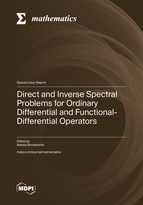Direct and Inverse Spectral Problems for Ordinary Differential and Functional-Differential Operators
A special issue of Mathematics (ISSN 2227-7390). This special issue belongs to the section "C1: Difference and Differential Equations".
Deadline for manuscript submissions: closed (30 November 2023) | Viewed by 25913
Special Issue Editor
2. Senior Researcher, Department of Mechanics and Mathematics, Saratov State University, Astrakhanskaya 83, 410012 Saratov, Russia
3. S.M. Nikolskii Mathematical Institute, Peoples' Friendship University of Russia (RUDN University), Miklukho-Maklaya Street 6, 117198 Moscow, Russia
Interests: inverse spectral problems; ordinary differential equations; functional analysis; Sturm-Liouville problems; differential operators on graphs; differential operators with distribution coefficients; partial inverse problems
Special Issue Information
Dear Colleagues,
This Special Issue is devoted to the spectral theory of ordinary differential and functional–differential operators. Both direct and inverse spectral problems are included. Such problems play a fundamental role in mathematics and have applications in various fields of science and engineering, e.g., in quantum and classical mechanics, geophysics, acoustics, and electronics.
Direct spectral problems consist in studying the properties of spectral characteristics such as asymptotical formulas for eigenvalues and eigenfunctions, trace formulas, completeness and basicity of root functions, eigen convergence theorems, etc.
Inverse spectral problems consist in the recovery of operators from their spectral characteristics. In recent years, the theory of inverse problems has been actively developing not only for differential operators, but also for integro-differential operators, functional–differential operators with delays, with frozen arguments, and other related classes of operators.
The topics of the potential submissions are not limited to the issues mentioned above. Papers on applications of spectral problems (e.g., to linear and nonlinear partial differential equations) are also encouraged.
Prof. Dr. Natalia P. Bondarenko
Guest Editor
Manuscript Submission Information
Manuscripts should be submitted online at www.mdpi.com by registering and logging in to this website. Once you are registered, click here to go to the submission form. Manuscripts can be submitted until the deadline. All submissions that pass pre-check are peer-reviewed. Accepted papers will be published continuously in the journal (as soon as accepted) and will be listed together on the special issue website. Research articles, review articles as well as short communications are invited. For planned papers, a title and short abstract (about 100 words) can be sent to the Editorial Office for announcement on this website.
Submitted manuscripts should not have been published previously, nor be under consideration for publication elsewhere (except conference proceedings papers). All manuscripts are thoroughly refereed through a single-blind peer-review process. A guide for authors and other relevant information for submission of manuscripts is available on the Instructions for Authors page. Mathematics is an international peer-reviewed open access semimonthly journal published by MDPI.
Please visit the Instructions for Authors page before submitting a manuscript. The Article Processing Charge (APC) for publication in this open access journal is 2600 CHF (Swiss Francs). Submitted papers should be well formatted and use good English. Authors may use MDPI's English editing service prior to publication or during author revisions.
Keywords
- direct spectral problems
- inverse spectral problems
- scattering problems
- ordinary differential operators
- boundary value problems
- eigenvalue asymptotics
- basicity of root functions
- integro-differential operators
- functional–differential operators with delay
- functional–differential operators with frozen argument
- functional–differential operators with involution
Benefits of Publishing in a Special Issue
- Ease of navigation: Grouping papers by topic helps scholars navigate broad scope journals more efficiently.
- Greater discoverability: Special Issues support the reach and impact of scientific research. Articles in Special Issues are more discoverable and cited more frequently.
- Expansion of research network: Special Issues facilitate connections among authors, fostering scientific collaborations.
- External promotion: Articles in Special Issues are often promoted through the journal's social media, increasing their visibility.
- Reprint: MDPI Books provides the opportunity to republish successful Special Issues in book format, both online and in print.
Further information on MDPI's Special Issue policies can be found here.






